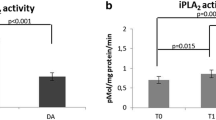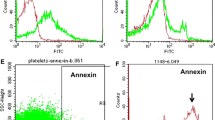Abstract
Phospholipase A2 (PLA2) is a key enzyme in the metabolism of membrane phospholipids. PLA2 influences the processing and secretion of the amyloid precursor protein, which give rise to the β-amyloid peptide, the major component of the amyloid plaque in Alzheimer's disease (AD). We investigated the PLA2 activity in two samples: in post-mortem brains from 23 patients with AD and 20 non-demented elderly controls, and platelets from 16 patients with a diagnosis of probable AD, 13 healthy controls and 14 elderly patients with a major depression. In AD brains PLA2 activity was significantly decreased in the parietal, and to a lesser degree in the frontal, cortex. Lower PLA2 activity correlated significantly with an earlier onset of the disease, an earlier age at death and higher counts of neurofibrillary tangles and senile plaques. In platelets PLA2 activity was also significantly reduced in the AD group as compared with healthy and depressed controls. The reduction of the enzyme activity in platelets correlated with an early disease onset and with the severity of cognitive impairment, indicating a relationship between abnormally low PLA2 activity and a more severe form of the illness. The present results provide new evidence for a disordered phospholipid metabolism in AD brains and suggest that reduced PLA2 activity may contribute to the production of amyloidogenic peptides in the disease. Further studies are needed to examine whether PLA2 activity in platelets may be useful as a peripheral marker for a subgroup of patients with AD.
Similar content being viewed by others
References
Bazan HEP, Ridneour B, Birkle DL, Bazan NG (1986) Unique metabolic features of docosahexanoate metabolism related to functional roles in brain and retina. In: Horroks LA, Freysz L, Toffano G (eds) Phospholipid research and the nervous system. Biochemical and molecular pharmacology. Fidia Research Series, Vol 4. Liviana Press, Padova, pp 67–78
Brown GG, Levine SR, Gorell JM, Pettegrew JW, Gdowski JW, Bueri JA, Helpern JA, Welch KMA (1989) In vivo 31P NMR profiles of Alzheimer's disease and multiple subcortical infarct dementia. Neurology 39:1423–1427
Coporaso GL, Gandy SE, Buxbaum JD, Ramabhadran TV, Greengard P (1992) Protein phosphorylation regulated secretion of Alzheimer βA4 amyloid precursor protein. Proc Natl Acad Sci USA 89:3055–3059
Dyrks T, Weidermann A, Multhaup G, Salbaum JM, Lemaire HG, Kang J, Buller-Hill B, Masters CL, Beyreuther K (1988) Identification, transmembrane orientation and biogenesis of the amyloid A4 precursor of Alzheimer's disease. EMBO J 7:949–957
Emmerling MR, Moore CJ, Doyle PD, Carroll RT, Davis RE (1993) Phospholipase A2 activation influences the processing and secretion of the amyloid precursor protein. Biochem Biophys Res Commun 197:292–297
Farooqui AA, Liss L, Horroks LA (1990) Elevated activities of lipases and lysophospholipase in Alzheimer's disease. Dementia 1:208–214
Folstein M, Folstein S, McHugh P (1975) Mini-Mental State, J Psychiatry Res 12:189–198
Förstl H, Burns A, Levy R, Cairns N, Luthert P, Lantos P (1992) Neurologic signs in Alzheimer's disease: results of a prospective clinical and neuropathologie study. Arch Neurol 49:1038–1042
Gattaz WF, Maras A, Cairns NJ, Levy R, Förstl H (1995a) Decreased phospholipase A2 activity in Alzheimer brains. Biol Psychiatry 37:13–17
Gattaz WF, Schmitt A, Maras A (1995b) Increased platelet phospholipase A2 activity in schizophrenia. Schizophr Res 16:1–6
Kanfer JN, Hattori H, Orihel D (1986) Reduced phospholipase D activity in brain tissue samples from Alzheimer's disease patients. Ann Neurol 20:265–267
Sharp JD, White DL, Chiou XG, Goodson T, Gamboa GC, McClure D, Burgett S, Hoskins J, Skatrud PL, Sportsman JR, Becker GW, Kang LH, Roberts E, Kramer RM (1991) Molecular cloning and expression of human Ca2+-sensitive cytosolic PLA2. J Biol Chem 266:14850–14853
Skinner ER, Watt C, Besson JAO, Best PV (1989) Lipid composition of different regions of the brain in patients with Alzheimer's disease. Biochem Soc Trans 17:213–214
Smith RP, Higuschi DA, Broze GJ Jr (1990) Platelet coagulation factor 1xa-inhibitor, a form of Alzheimer amyloid precursor protein. Science 248:1126–1128
Author information
Authors and Affiliations
Rights and permissions
About this article
Cite this article
Gattaz, W.F., Förstl, H., Braus, D.F. et al. Decreased phospholipase A2 activity in the brain and in platelets of patients with Alzheimer's disease. Eur Arch Psychiatry Clin Nuerosci 246, 129–131 (1996). https://doi.org/10.1007/BF02189113
Issue Date:
DOI: https://doi.org/10.1007/BF02189113




